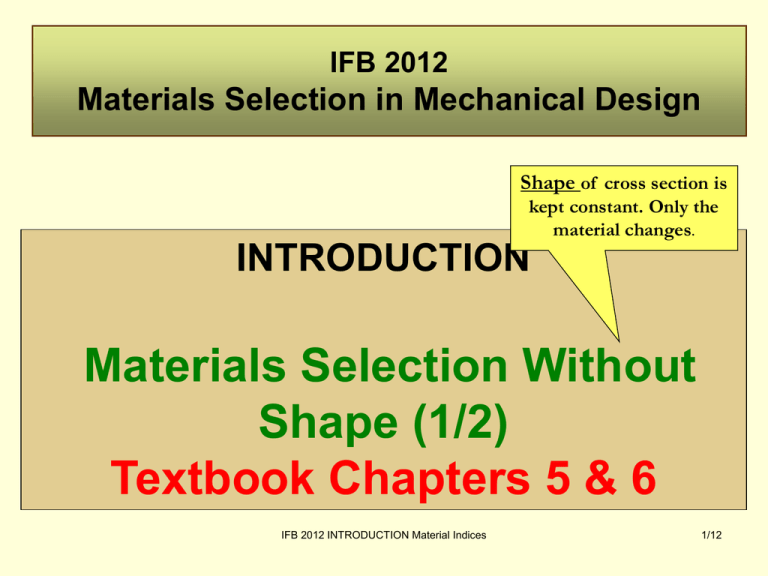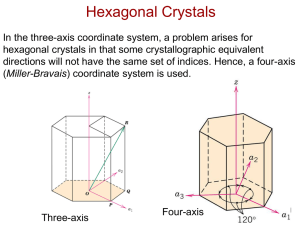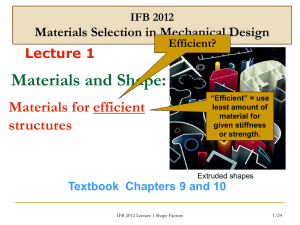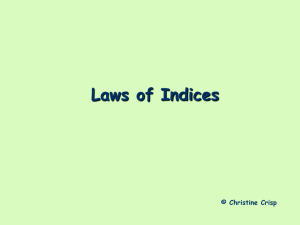Document
advertisement

IFB 2012
Materials Selection in Mechanical Design
Shape of cross section is
kept constant. Only the
material changes.
INTRODUCTION
Materials Selection Without
Shape (1/2)
Textbook Chapters 5 & 6
IFB 2012 INTRODUCTION Material Indices
1/12
Deriving Materials Indices, Example 1: Material for a stiff, light beam
Beam (solid square
section)
Minimise mass, m:
Function
Goal
2
m AL b L
Constraint
Stiffness of the beam, S:
Get these equations
from the textbook,
or pdf file “Useful
Solutions”
S
F
δ
S
CEI
L
3
4
I = second moment of area: I b
12
What can be
varied ?
{
• Material choice
• Area = b2
12 S L5
m
C
1/ 2
To minimise the mass
1/ 2
E
m = mass A = cross section
L = length
= density
b = edge length
S = stiffness
I = second moment of area
E = Young’s modulus
b2 = m/L
b2 = bFree
4 = 12variable
SL3/CE
(Trade-off variable)
Material
Index
E
Chose materials with largest M=
1/ 2
IFB 2012 INTRODUCTION Material Indices
Maximise Material Index !
2/12
Elastic Bending of Beams and Panels; p. 533 or from pdf file “useful solutions”
S
S
S
F
δ
F
C 1 EI
3
L
CEI
L
3
I ??
IFB 2012 INTRODUCTION Material Indices
3/12
Moments of Sections; p 531, or file “Useful Solutions”
I
b
4
12
IFB 2012 INTRODUCTION Material Indices
4/12
Deriving Materials Indices, Example 2: Material for a stiff, light panel
Function
Goal
Panel, width w
and length L specified
Minimise mass, m
m AL w t L
Constraint
Stiffness of the panel, S
S
F
S
δ
CEI
L
3
I
Free
• Material choice.
{• Panel thickness t
variable..??
What can be
varied ?
12 S w 2
m
C
1/ 3
2
L
1/ 3
E
wt
3
12
Eliminate t
m = mass
w = width
L = length
= density
t = thickness
S = stiffness
I = second moment of area
E = Young’s modulus
Material
Index
E
Chose materials with largest M=
IFB 2012 INTRODUCTION Material Indices
1/ 3
5/12
Material Indices for Minimum Mass
Function
Objective: minimise mass
Same Volume
Index
1/ ρ
E/ ρ
Tension (tie)
Objective: minimise
mass for given stiffness
Bending (beam)
Bending (panel)
To minimise the mass
E
E
1/2
1/3
/ρ
/ρ
Maximise Material Index !
IFB 2012 INTRODUCTION Material Indices
6/12
Materials Selection using charts: effect of slope of selection line
Exam question: What
is the Physics behind
Index
the different
exponents in the
Different
materials are
Indices’ equations?
selected, depending on the
slope of the selection line
E
1/ 3
M
E
1/ 2
M
E
M
Selection line
slope 1
Selection line
slope 2
Selection line
slope 3
MECH4301 2011 Lecture 2 Charts
7/12
Demystifying Material Indices
This is how the
world looks like
after you pass the
Materials
Selection Course
IFB 2012 INTRODUCTION Material Indices
8/12
Demystifying Material Indices (beam, elastic bending)
Material 1, Mass 1
stiffness S
Materials 2, Mass 2
stiffness S
12 S L
m 1
C
5
1/ 2
1
1 / 2
E1
2
1 / 2
m1
E2
m2
12 S L
m 2
C
5
E 11 / 2
1
1/ 2
2
1 / 2
E2
M1
M2
For given shape, the reduction in mass at
constant bending stiffness is given by the
reciprocal of the ratio of material indices.
Same applies to bending strength.
IFB 2012 INTRODUCTION Material Indices
9/12
Example: How good are Mg and Al when it comes to reducing mass?
A 10 kg component made of Steel…
E
m2/m1 = M1/M2
Exam question: Which beam is fatter??
E
1/ 2
E
1/ 3
Mg
Steel
Same: Which panel is thicker??
E
(GPa) (Mg/m3) Tie-rod Beam
Panel
Equal
Volume
Steel
210
7.8
10
10
10
10
Al
75
2.7
10
5.9
4.9
3.5
Mg
44
1.7
11
5.1
3.9
2.2
heavier
IFB 2012 INTRODUCTION Material Indices
lighter
10/12
Comparative weight of panels of equal stiffness
The Mg-Li
(Steel, Ti, Al and Mg) (Emley, Principles of Mg Technology
)
panel is thicker
(GPa)
(GPa)
(Mg/m33)
(Mg/m )
Relative
weight
mass
MgLi
44
1
3
Mg
44
1.7
4
Al
75
2.7
5
Ti
115
4.5
7
Steel
210
7.8
10
E
E
IFB 2012 INTRODUCTION Material Indices
11/12
Example of solution to Tutorial # 1 (Exercise 7.3)
IFB 2012 INTRODUCTION Material Indices
12/12
Example of solution to Tutorial # 1 (Exercise 7.3)
Derivation of the Material Index:
When fully loaded, the beam should not fail, i.e., maximum < * (yield strength)
m = lA
Solve for A= m/l.
The maximum force is
Solving for m:
3/2
*
I *
C m
F C
l 6 l5/2 3/2
y
m
6
m
C
2/3
F
2/3
5/3
L
* 2/3
( )
I/ym =A3/2/6
Material Index : M = (*)2/3/.
Select using the - chart with a line of slope 1.5, on the upper left corner.
2011 Lecture 3 Material Indices
13/12
Select using the - chart with a line of
slope 1.5, upper left corner.
Titanium alloys
Stainless steel
CFRP, epoxy matrix (isotropic)
1000
Silicon carbide
Magnesium alloys
Magnesium alloys
Polyamides (Nylons, PA)
Wood, typical along grain
Tensile strength (MPa)
100
Bamboo
Rigid Polymer Foam (HD)
Aluminum alloys
GFRP, epoxy matrix (isotropic)
Copy the results from CES
Sort the materials by their Index
Name
CFRP, epoxy matrix
Wood, typical along grain
Flexible Polymer Foam
Magnesium alloys
Polyamides (Nylons, PA)
X-Axis
1500 - 1600
600 - 800
16 - 35
1740 - 1950
1120 - 1140
Y-Axis
550 - 1050
60 - 100
0.24 - 0.85
185 - 475
90 - 165
Stage 1: Index
0.05375
0.02626
0.02488
0.02414
0.02175
Rigid Polymer Foam (LD)
Silicon carbide
GFRP, epoxy matrix
Titanium alloys
Bamboo
Flexible Polymer Foam (LD)
36 - 70
3100 - 3210
1750 - 1970
4400 - 4800
600 - 800
38 - 70
0.45 - 2.25
400 - 610
138 - 241
300 - 1625
36 - 45
0.24 - 2.35
0.02
0.01981
0.01732
0.01713
0.01695
0.01602
Alumina
Rigid Polymer Foam (MD)
Stainless steel
Polyester
Low alloy steel
High carbon steel
Flexible Polymer Foam
Aluminum alloys
3800 - 3980
78 - 165
7600 - 8100
1040 - 1400
7800 - 7900
7800 - 7900
70 - 115
2500 - 2900
350 - 588
0.65 - 5.1
480 - 2240
41.4 - 89.6
550 - 1760
550 - 1640
0.43 - 2.95
58 - 550
0.01518
0.01314
0.01306
0.01283
0.0126
0.01261
0.01207
0.01178
10
Rigid Polymer Foam (MD)
Flexible Polymer Foam (LD)
Selection line gradient1.5
1
100
1000
10000
Density (kg/m^3)
Conclusions to the chart/table: Composites, timber are the
best materials. Al, Mg and steels are good competitors.
Foams perform generally well, due to their low density.
However, if made out of foams, the beams will be rather
fat/big!
2011 Lecture 3 Material Indices
14/12
The End Introduction
IFB 2012 INTRODUCTION Material Indices
15/12
The CES software:
Demonstration
IFB 2012 INTRODUCTION Material Indices
16/12
Organising information: the MATERIALS TREE
Kingdom
Family
• Ceramics
& glasses
Materials
• Metals
& alloys
Class
Steels
Cu-alloys
Al-alloys
Ni-alloys
Zn-alloys
• Hybrids
Attributes
Density
Ti-alloys
• Polymers
& elastomers
Member
1000
2000
3000
4000
5000
6000
7000
8000
Mechanical props.
Thermal props.
Electrical props.
Optical props.
Corrosion props.
Supporting information
-- specific
-- general
A material record
IFB 2012 INTRODUCTION Material Indices
17/12
CES : the 3 levels
3400
Level 2 enough
for most
exercises
IFB 2012 INTRODUCTION Material Indices
18/12
Chart created with the CES software (level 1, 60 materials)
Alumina
CFRP, epoxy matrix (isotropic)
E
100
Tungsten carbides
Silicon
Tungsten alloys
Wood, typical along grain
Brick
Zinc alloys
Rigid Polymer Foam (HD)
10
Young's modulus (GPa)
Rigid Polymer Foam (MD)
Wood, typical across grain
Concrete
Lead alloys
1
Rigid Polymer Foam (LD)
Polyvinylchloride (tpPVC)
Leather
0.1
Cork
0.01
Silicone elastomers
1e-3
Polychloroprene (Neoprene, CR)
Flexible Polymer Foam (VLD)
100
Density (kg/m^3)
1000
IFB 2012 INTRODUCTION Material Indices
10000
density
19/12
Chart created with the CES software (level 3, ~3400 materials)
Diamond
1000
Palm (0.35)
100
E
Balsa (l) (ld)
10
Polymethacrylimide Foam:
Young's modulus (GPa)
Tin-Lead 63-37 Solder
1
Metal Impregnated Carbon
Melamine Foam
Leather
0.1
Silicone elastomer (Shore A40)
0.01
Silicone elastomer
1e-3
Ethylene-Propylene Rubber (EPM)
1e-4
Polyurethane Foam
1e-5
10
100
Density (kg/m^3)
1000
IFB 2012 INTRODUCTION Material Indices
10000
density
20/12
Ranking Materials using Charts
Selection line
for beams
Selection line
for tie rods
ceramics
Selection corner
Selection line
for panels
E
1
E
E
C
C
E
1/ 3
foams
3
1/ 2
2
C
metals
composites
& polymers
One very significant conclusion from this
course, so far: For beams and panels,
materials with very low density are more
important than for tie-rods. This is why foams
are not used for tie rods, but are preferred for
beams and more so for flat panels.
Important: Read textbook pp.93-95: Summary
and Conclusions to Ch. 4, Properties of charts.
IFB 2012 INTRODUCTION Material Indices
21/12
Material Indices for Minimum Cost?
Same for embodied energy Q = q, etc.
mass = xV
price [c ] = $/kg
Total cost C = c x mass = c V
Total cost C c [$/m3]
[ c ] = [$/m3] “price density”
Goal: minimise cost
Performance metric =
cost per given stiffness
Function
Index
Tension (tie)
E/ cρ
Bending (beam)
E
1/2
/ cρ
Bending (panel)
E
1/3
/ cρ
To minimise the cost
Maximise Material Index !
IFB 2012 INTRODUCTION Material Indices
22/12
Comparative stiffness of panels of equal weight
(Steel, Ti, Al and Mg) (Emley, Principles of Mg Technology)
Relative
stiffness
E
(GPa)
(Mg/m3)
MgLi
44
1
23
Mg
44
1.7
19
Al
75
2.7
8
Ti
115
4.5
3
Steel
210
7.8
1
IFB 2012 INTRODUCTION Material Indices
23/12
Material for a stiff tie-rod of minimum mass
Function
Constraints
Tie-rod
{
• Length L is specified
• Must not deflect more than
under load F
m = mass
= density
E = Young’s modulus
= deflection
Equation for constraint on :
≤ L = L /E = L F/A E
Goal
A = LF/E
Minimise mass m:
m = AL
What can be varied
to meet the goal ?
Performance
metric: mass
{
Material
Index
• Material
• Cross section area A
L F
m
2
E
E
Chose materials with largest M =
IFB 2012 INTRODUCTION Material Indices
To minimise the mass
A = Free variable ; or
Trade-off variable
24/12
Maximise Material Index !
Materials for a strong, light beam
Function
Beam (shaped section).
Objective
Minimise mass, m, where:
Area A
m AL
Constraint
Bending strength of the beam Mf:
M
I
f
Z
*
ym
Ab
2
*
Z
bh
8
2
b
3
m = mass
A = area
L = length
= density
Mf = bending strength
I = second moment of area
E = Youngs Modulus
Z = section modulus
8
m
L
Combining the equations to eliminate A gives:
m 6 F f
2/3
5/3
L
* 2/3
* 2/3
Chose materials with largest M =
IFB 2012 INTRODUCTION Material Indices
To minimise the mass
Maximise Material Index !
25/12
Failure of Beams; p. 535
IFB 2012 INTRODUCTION Material Indices
26/12
Moments of Sections; p 531
IFB 2012 INTRODUCTION Material Indices
27/12
Materials for a strong, light tie-rod
Strong tie of length L and minimum mass
Function
Tie-rod
F
F
Area A
L
Constraints
• Length L is specified
• Must not fail under load F
Equation for constraint on A:
F/A < y
(1)
Objective
(Goal)
Minimise mass m:
m = AL
Free variables
• Material choice
• Section area A.
Performance
metric m
m FL
y
m = mass
A = area
L = length
= density
y= yield strength
(2)
Eliminate A in (2) using (1):
Chose materials with largest M =
IFB 2012 INTRODUCTION Material Indices
To minimise the mass
y
28/12
Maximise Material Index !
Material Indices
An objective defines a performance metric: e.g. mass or cost.
The equation for the performance metric contains material properties.
Sometimes a single property
Sometimes a combination
Function
Example
Objective:
minimise mass
Performance
metric = mass
Either is a material index
Stiffness
Tension (tie)
E/ ρ
Bending (beam)
E
1/2
/ρ
Bending (panel)
E
1/3
/ρ
Strength
y /ρ
IFB 2012 INTRODUCTION Material Indices
2/3
σy /ρ
1/2
σy /ρ
29/12
Material Indices
Each combination of
Function
Constraint
Objective
Free variable
has a
characterising
material index
Maximise this!
INDEX
E
M
1/ 2
INDEX
y
M
Maximise
this!
IFB 2012 INTRODUCTION Material Indices
30/12
The End Introduction
IFB 2012 INTRODUCTION Material Indices
31/12








